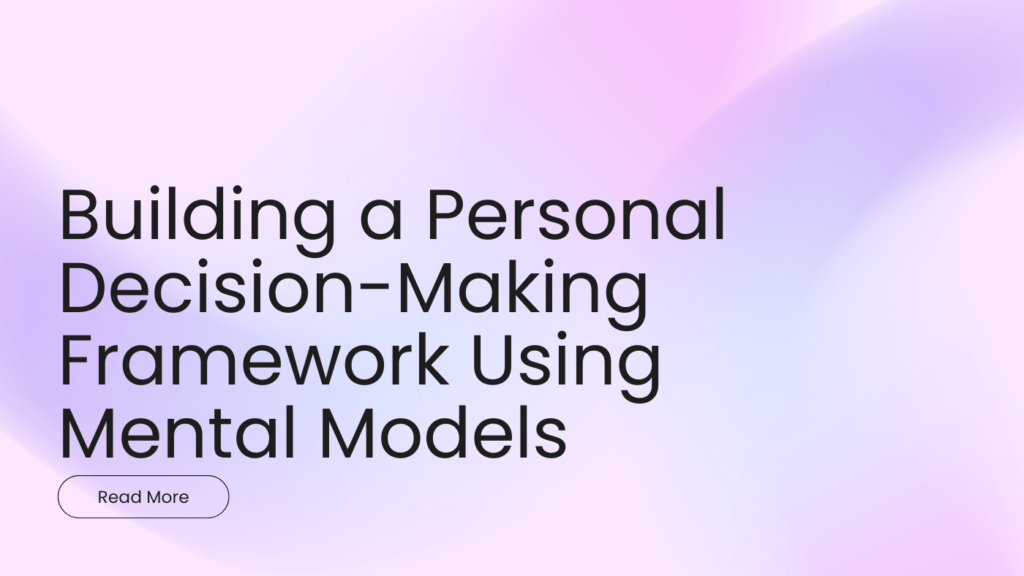Building a Personal Decision-Making Framework Using Mental Models
We all make decisions, big and small, every single day. From choosing what to eat for breakfast to charting a new career path, our lives are shaped by the choices we make. But how can we ensure we’re making the best decisions, consistently? The answer lies in developing a robust personal decision-making framework, and a powerful tool to populate that framework is through the strategic application of mental models.
What are Mental Models?
Mental models are simplified representations of how something works. They’re shortcuts our brains use to understand complex systems and make predictions about the world. Think of them as tools in a toolbox, each suited for a specific type of problem.
As Charlie Munger, Warren Buffett’s long-time business partner, famously advocates, having a “latticework of mental models” is crucial for clear thinking and effective decision-making. (Munger, C. T. (2007). Poor Charlie’s Almanack: The Wit and Wisdom of Charles T. Munger. Third Edition. PCA Publications.)
Instead of memorizing endless facts, mental models provide a framework for understanding the underlying principles that govern various situations. By applying the right mental model, you can cut through the noise and make more informed choices.
Why Use a Personal Decision-Making Framework?
Without a framework, decision-making can become haphazard, driven by emotion or gut feeling. This can lead to inconsistent results and missed opportunities. A well-defined personal decision-making framework provides several key benefits:
- Consistency: Ensures you approach decisions with a standardized, logical process.
- Clarity: Forces you to define your goals, values, and priorities, leading to more focused choices.
- Reduced Bias: Helps to identify and mitigate cognitive biases that can cloud your judgment.
- Improved Outcomes: Leads to better decisions and ultimately, better results.
- Faster Decision-Making: Familiarity with your framework allows you to quickly analyze situations.
Building Your Framework: A Step-by-Step Guide
Creating a personal decision-making framework is an iterative process. Here’s a step-by-step guide to get you started:
1. Define Your Core Values and Goals
What truly matters to you? What are your long-term aspirations? Identifying your core values (e.g., honesty, integrity, creativity) and setting clear goals (e.g., financial independence, career advancement, personal growth) is the foundation of your framework. Your decisions should align with these guiding principles.
2. Identify Common Decision-Making Scenarios
What types of decisions do you face regularly? Are they primarily financial, career-related, relationship-oriented, or health-related? Categorizing your decisions will help you select the most appropriate decision-making models and mental models for each scenario.
3. Select Relevant Mental Models
This is where the real power lies. Here are a few examples of mental models that can be particularly useful in everyday life:
- First Principles Thinking: Break down a problem into its fundamental components and reason up from there. (Musk, E. (2015). Elon Musk: Tesla, SpaceX, and the Quest for a Fantastic Future. Ecco.) This is excellent for creative problem-solving and innovation.
- Inversion: Instead of asking “How can I succeed?”, ask “How can I fail?”. By identifying potential pitfalls, you can proactively avoid them.
- Occam’s Razor: The simplest explanation is usually the best. Avoid overcomplicating situations and focus on the most straightforward solution.
- The Pareto Principle (80/20 Rule): Focus your efforts on the 20% of activities that yield 80% of the results. This helps prioritize tasks and maximize efficiency.
- Loss Aversion: Recognize that people tend to feel the pain of a loss more strongly than the pleasure of an equivalent gain. Be aware of this bias when making investment decisions. (Kahneman, D., & Tversky, A. (1979). Prospect Theory: An Analysis of Decision under Risk. Econometrica, 47(2), 263-291.)
- Second-Order Thinking: Consider the consequences of your actions, and then the consequences of those consequences. This helps you anticipate unintended outcomes and make more thoughtful decisions.
For example, when considering a new job offer, you might apply First Principles Thinking to analyze the company’s business model, Inversion to identify potential career risks, and Second-Order Thinking to consider the long-term implications for your personal life.
4. Create a Decision-Making Process
Now, map out the steps you’ll take when faced with a decision. This might involve:
- Defining the Problem: Clearly articulate the decision you need to make.
- Gathering Information: Collect relevant data and perspectives.
- Generating Alternatives: Brainstorm multiple options.
- Evaluating Options: Apply your chosen mental models to assess each option.
- Making a Decision: Choose the option that best aligns with your values and goals.
- Evaluating the Outcome: Reflect on the results of your decision and learn from the experience.
Document this process. A flowchart or checklist can be helpful.
5. Practice and Refine
Your personal decision-making framework is not set in stone. It’s a living document that should evolve as you learn and grow. Regularly review your decisions, identify areas for improvement, and adjust your framework accordingly. The more you use it, the more intuitive it will become.
Mental Models in Everyday Life: Practical Examples
The beauty of mental models is their applicability across various domains. Here are some real-world examples of how to apply them:
- Investing: Applying the “Margin of Safety” (buying assets at a significant discount to their intrinsic value) can help mitigate risk and increase the likelihood of long-term success.
- Relationships: The “Hanlon’s Razor” principle (“Never attribute to malice that which is adequately explained by stupidity”) encourages empathy and prevents unnecessary conflict.
- Project Management: Using “Parkinson’s Law” (work expands so as to fill the time available for its completion) can help you manage your time more effectively by setting realistic deadlines.
- Communication: Employing “Active Listening” techniques (paying close attention to the speaker, asking clarifying questions, and providing feedback) can improve understanding and build stronger relationships.
Overcoming Common Pitfalls
Building and using a personal decision-making framework isn’t always easy. Here are some common pitfalls to watch out for:
- Analysis Paralysis: Overthinking and getting stuck in the evaluation phase. Set time limits for each step of your process.
- Confirmation Bias: Seeking out information that confirms your existing beliefs, while ignoring contradictory evidence. Actively seek out opposing viewpoints.
- Emotional Decision-Making: Allowing emotions to cloud your judgment. Take a step back and objectively evaluate the situation.
- Rigidity: Being unwilling to adapt your framework when necessary. Be open to new information and perspectives.
Conclusion
Developing a robust personal decision-making framework powered by mental models is an investment in yourself and your future. By adopting a more structured and rational approach to decision-making, you can improve your outcomes, reduce stress, and live a more fulfilling life. Start building your framework today, experiment with different decision-making models, and witness the transformative power of clear thinking in mental models in everyday life.


